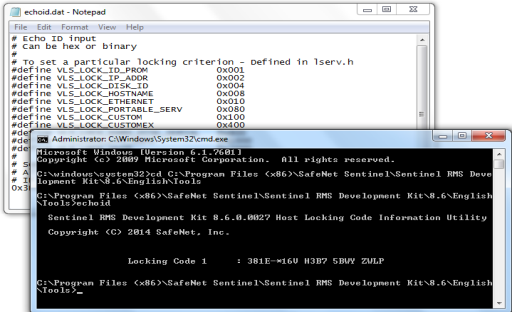Generating Locking Codes
The locking code comes into the picture when you are about to generate the license code for your customer(s). Your customers run the utility on the required computer(s)—can be one or multiple clients and/or License Managers. However, this needs to be planned in advance, as you need to obtain it from your customer(s).
Here are the ways of obtaining a locking code:
>Wechoid - A Windows-based utility to generate locking codes. You specify to the customer which locking criteria to use in Wechoid.
>echoid - A command-line utility available on Windows, UNIX, and Linux ARM sends the output to a console window. echoid uses the echoid.dat file that defines what criteria will make up the fingerprint. The file echoid.dat must be in the current working directory from where echoid program file is run. To specify what criteria to use for the computer fingerprint, use a text editor to modify a copy of the file echoid.dat . The fingerprint criteria are bit values that are ORed to form a byte. For example, the hexadecimal value 0x4 selects the hard disk ID. The value 0x2 selects the IP address. To select both the hard disk ID and the IP address, add the values together and enter the ORed sum at the end of the file: 0x6. You will ship this modified file to your customers.
For steps on generating a locking codes using echoid or Wechoid, refer to the Sentinel RMS SDK System Administrator Help.
>Custom utility/option - You can create a customized utility that calls one of the following locking-related API functions.
•Unified API - Use the lockCodeInfo query type of sntl_licensing_get_info () API to generate locking code for a target machine.
•Traditional API - Use the VLSmachineIDtoLockCode API function, using the values provided by your customers as machineID. It will return a string-based locking code.
For more information, refer to the Sentinel RMS API Reference Guide for details about the locking code API functions.

Figure 1: The Echoid.dat File and echoid Utility
NOTE If the locking criteria specified is not available on a system, the locking code will be generated based on the available criteria only.
About New Style and Old Style Locking Codes
By default, the locking utilities generate the “new style” locking code—a string similar to the following:
*1KM VW64 SS28 Q9MT
The “old style” locking code, a string smaller in size, is to be generated only for specific purposes. For example, when your customers want to clean persistence data of licenses earlier than version 11, the “old style“ locking code is required.
This distinction came into existence since the Sentinel RMS 8.1.0 release for Windows, when some enhancements were made in the locking code, which makes it different from that of the previous releases.
> The 16-byte long locking codes introduced in v8.1,0 are referred to as “new style”.
>The 8-byte long locking codes belonging to versions earlier than 8.1.x are referred to as “old style.”
The table below classifies the locking codes as per the RMS SDK version:
| Product Version |
License Version |
Size of the Locking Code |
Referred to as in Wechoid/echoid... |
|---|---|---|---|
| Sentinel RMS 8.1.0 and later | v11 and later | 16 bytes | New style |
| Sentinel RMS 8.0 | v10 | 8 bytes | Old style |
| Sentinel RMS 7.3.x | v9 | 8 bytes | Old style |
| Sentinel RMS 7.3 | v8 | 8 bytes | Old style |
| Sentinel RMS 7.2 | v7 | 8 bytes | Old style |
The echoid and Wechoid screenshots illustrate the two styles of locking codes.

Figure 2: Locking Codes
NOTE Old style locking codes are not displayed by the Wechoid for Windows Vista and its successors.
